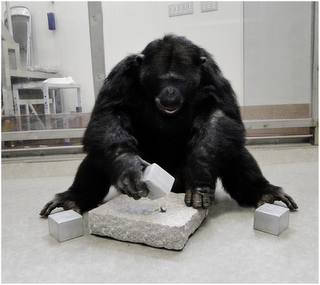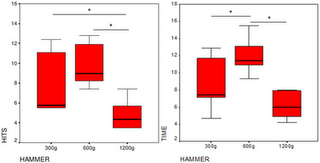This caught my attention because weight is not actually the only key property that determines nut cracking success. A heavy hammer is great, but it will eventually become too heavy to lift, and for a given size stone there may very well be an optimum weight (similar to how people choose very specific combinations of size and weight when asked to throw objects to a maximum distance; Zhu & Bingham, 2011). In the current experiment, when the only difference between the objects was weight, the chimpanzees often went to the heaviest stone because it took the fewest strikes and least time to crack the nut. But is this just an artefact of the current experiment? And if so, can an ecological approach find ways to find out just how chimps choose their tools?
The experimentThere were three experiments, all with the same 6 chimpanzees. One key feature to remember, therefore, is that over the course of the study the chimps all had a lot of practice at this task - this is very interesting and reflected in the data.
Experiment 1 used roughly cube shaped hammer stones (6cm x 8cm x 6cm) that weighed 300g, 600g or 1200g. The weight was evenly distributed throughout the objects. The chimps were asked to choose a stone and crack a nut, and were allowed to switch stones if they wanted to.
 Two of the chimps exhibited a preference for a hammer; Loi preferred the heavy one and Zamba preferred the light one. There was no preference on average, however. All the hammers could successfully crack a nut: when used, however, the heaviest hammer took fewer strikes and less time than the others to crack the nut. There was very little switching around between hammers, however.
Two of the chimps exhibited a preference for a hammer; Loi preferred the heavy one and Zamba preferred the light one. There was no preference on average, however. All the hammers could successfully crack a nut: when used, however, the heaviest hammer took fewer strikes and less time than the others to crack the nut. There was very little switching around between hammers, however. The cuboid was awkward to hold (hint one that weight is not the only key factor). To crack a nut the chimps had to align a flat side with the anvil stone and could therefore misalign the hammer, wasting a strike. In the next two experiments the hammer stones were replaced with 7cm spheres of the same, evenly distributed weights.
Experiment 2 showed an overall group preference for the heaviest object, although no individual chimp showed this preference significantly. Experiment 3 increased the weight range (to 200g, 800g and 1400g) and found a stronger preference for the heaviest hammer; 4 of the 6 chimps showed the effect and would often switch away from the lighter hammers if they picked one up first.
Over time, with practice and a wide range of weights, 4 of the chimps learned to use weight to identify the most efficient hammer stone from the set available.
What to do next?There are many things to try next, if you are prepared to think about this task ecologically and measure some more interesting things.
AffordancesFirst, weight was clearly not the only relevant property. In Experiment 1, the number of strikes and time to crack the nut did not decrease as a linear function of weight - the middle weight was problematic.

Number of hits and time to crack the nut as a function of hammer weight
Changing to the spherical object cleaned this up - so clearly size and shape matter. Part of makes a good hammer stone is how graspable it is by the chimps. So the first thing to do is to vary the maximum object extent (Mon-Williams & Bingham, 2011) and to do so relative to hand span. You could also add handles, etc. You can also vary size and weight independently within a shape - do chimps learn preferences for specific combinations, as humans do in throwing? What about other properties of the hammer stone? Is it rigid and strong enough? (There's evidence of apes using different stones for different nuts in the wild, for example).All of this manipulates the affordances of the hammer, specifically how moveable it is (Shockley, Carello & Turvey, 2004) and how easy it is to wield as a hammer. Exactly which properties of the hammer the chimps are tuning into is an empirical question, and the current study has limited their search space artificially. By letting them explore a set of hammers with a controlled but wide set of potential properties, we could identify what the chimps are actually perceiving.
Information Once we know what they are perceiving, we can ask how are they perceiving it - this means studying information.
This, unfortunately, is complicated in haptic perception. Research has demonstrated that when we wield objects, the dynamic property we perceive is not mass or size per se, but the resistance of the object to being moved - it's inertia. The description of the objects inertia in 3D space is called the inertia tensor and the perception of object properties via this tensor is called dynamic touch (Turvey, 1996).
The problem is that, while we're pretty sure the inertia tensor is the dynamic property being perceived, we do not know how this is specified in the kinematics (motion) of the haptic system (I mentioned this problem when discussing Withagen's work on non-specifying variables). It's a real obstacle; however, there are still plenty of experiments you can run to show that it is, indeed, the inertia that is the key affordance property, and not the weight.
For example, the weight in the hammers in the current study was evenly distributed throughout the objects. This means that the inertia tensor is symmetric (the object resists being moved equally in all directions; think about a tennis ball). To see if behavior follows the inertia tensor and not simply mass, you need to decouple these properties by changing the distribution of mass throughout the object (think about a tennis racquet). You then let the chimps interact with the objects and see what happens (well, it's a little more complicated than that but this is the basic idea).
There are also ways to present visual information about inertia; by setting the object in motion, there is visual information that reflects the underlying dynamic of the mass distribution, for example. Again, non-trivial to do with apes, but the principles are there to be adapted.
MeasurementsThe current study measured number of strikes and time required to crack the nut. One thing I noticed in the study is that the strike frequency decreased with mass; the chimps were wielding the objects differently. I would love to see more detailed kinematic analyses of the actions, relative to the inertial properties of the objects. If the hammer stone was marked with distinct colours or if the apes were happy to have passive markers placed on their wrists, you could digitise high speed video fairly easily to obtain these data.
I would also love to quantify the apes' exploration of the objects. There wasn't a huge amount, but there were some switches between objects, especially in the later experiments, as the chimps picked up and discarded the lighter hammers (they picked them up in the first place because the objects were designed to be visually indistinguishable). What did they do when they lifted the objects? Did they heft the hammers? How much time did it take?
SummaryThis paper assumes that weight is the key property in hammering open a nut. However, what the affordance property is that's shaping behavior is always an empirical question, as is the identity of the information that allows the affordance to be perceived. The relevant experimental tools exist from human studies, and I would love the opportunity to work with these authors to adapt these protocols to work with chimps. I think that an ecological task analysis and the related experimental techniques have a lot to add to this exploration of tool use in our closest relatives.

Mon-Williams, M. & Bingham, G.P. (2011). Discovering affordances that determine the spatial structure of reach-to-grasp movements. Experimental Brain Research, 211(1), 145-160. Download
Shockley, K., C. Carello, and M. T. Turvey (2004). Metamers in the haptic perception of heaviness and moveableness. Perception and Psychophysics, 66, 731 742.
Schrauf, C, Call, J, Fuwa, K, & Hirata, S (2012). Do Chimpanzees Use Weight to Select Hammer Tools? PLoSOne, 7 (7) DOI: 10.1371/journal.pone.0041044
Turvey, MT (1996). Dynamic touch. American Psychologist, 51(11), 1134-1152.
Zhu, Q. & Bingham, G.P. (2011). Human readiness to throw: the size- weight illusion is not an illusion when picking the best objects to throw. Evolution and Human Behavior, 32(4), 288-293.

